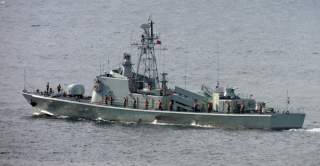The Chinese Navy and the Quest for Access
Why then do we have this agreement now by the Malaysian Navy for Chinese navy port access to Sabah?
In a quiet but undoubtedly significant event, Admiral Wu Shengli (吴胜利), commander of the People’s Liberation Army Navy and a member of the PRC’s Central Military Commission recently visited Malaysia with an entourage of 10 senior officials. During his visit, Admiral Wu secured agreement from the Malaysian Navy for the ships of the PLA Navy to use the port of Kota Kinabalu in Malaysian Borneo as a "stopover location" to "strengthen defence ties between the two countries."
What’s remarkable is the environment in which this agreement has been reached. China’s military vessels have been active in Malaysia’s territorial waters off Borneo from 2011. Since 2013, the number of Chinese naval and coast guard vessels patrolling and anchoring around Malaysia’s Luconia Shoals and James Shoal, both of which are within Malaysia’s exclusive economic zone, has increased greatly, and PRC territory markers have been erected on the latter.
In June, National Security Minister Shahidan Kassim said that Malaysia would protest to China about the PRC Coast Guard ship long anchored in Malaysian waters at Luconia Shoals, while legislators voiced their unhappiness with the situation. The Malaysian Foreign Ministry has more recently been lodging weekly protests with Beijing over the presence of the Chinese ship in the area. While the anchored PRC ship is being monitored, there have been reports that Malaysian fishermen are still being driven away from the shoals by Chinese threats to facilitate Chinese fishing boats’ exploitation of the area.
Further, only a day after Admiral Wu left Malaysia, the Malaysian Deputy Prime Minister and Minister of Home Affairs, Ahmad Zahid Hamidi, visited Sabah and started berating ‘a regional superpower’ which has built facilities on three atolls just 155km from Sabah and "3,218km from its mainland.' "To claim this part of the South China Sea as theirs due to historical narrative is invalid," the Deputy Prime Minister Zahid noted.
Why then do we have this agreement now by the Malaysian Navy for Chinese navy port access to Sabah? And which part of the Malaysian administration was responsible for approving it?
Access to a northern Borneo port has long been an ambition of the PLA Navy in its efforts to expand control in the South China Sea. Two years ago, in a Strategist posting entitled Xi Jinping and the Sabah enigma, I noted how Xi Jinping’s planned visit to Sabah (subsequently aborted) reflected PRC efforts to increase links with that key region of northern Borneo. Chinese naval personnel first visited Kota Kinabalu in August 2013.
Later that year, direct contact between Malaysia’s Naval Region Command 2 (Mawilla 2) and China’s Southern Sea Fleet Command was initiated and Defence Minister Hishammuddin Hussein invited China’s Defence Minister, General Chang Wanquan (常万全), to visit the Royal Malaysian Navy base in Teluk Sepanggar, Sabah, to jointly launch the tie-up. At the same time, Malaysia and China announced joint military exercises for 2014, eventually held in 2015 in the Strait of Malacca. A PRC consulate was established in Kota Kinabalu in April 2015 and the new consul-general began by urging that Chinese-language signs be erected across Sabah.
But back to Admiral Wu’s journey. During his current peregrination, Admiral Wu is visiting Malaysia, Indonesia and the Maldives, undoubtedly reflecting Chinese naval access aspirations in those three regions. This is one of three trips to neighbouring countries by senior PRC military officials this month. Admiral Sun Jianguo (孙建国), Deputy Chief of the PLA General Staff Department, accompanied Xi Jinping on his visit to Vietnam in early November. General Fan Changlong (范长龙), Vice Chairman of the Central Military Commission, is also currently leading a military delegation to Pakistan and India. A Global Times commentary suggests that all three trips are related to expanding China’s maritime interests.
In the light of these visits and increasing PRC maritime assertiveness, only the most innocent would, on observing the location of Darwin between the South China Sea and the Indian and South Pacific Oceans, conclude that the PLA Navy would not likewise be interested in securing access to and facilities in the port of Darwin. Particularly if it was under the control of a Chinese enterprise for the coming century.
This piece first appeared in ASPI’s The Strategist here.
Image: Creative Commons.

